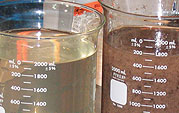Precipitation
Precipitation is the formation of a solid in a solution through a chemical reaction that forms an insoluble compound out of two or more soluble compounds. Precipitation is also the act of separating a solid from a solution. The solid that is formed is called the precipitate, and the liquid solution is called the supernate.
Precipitation is not to be confused with coagulation, although many in the industry use these terms interchangeably. Precipitation is the formation of a solid. Coagulation is the agglomeration of the solid particles.
In most situations, the solid that forms settles out of the solute phase, and settles to the bottom of the solution (though it will float if it is less dense than the solvent or form a suspension). The solid may reach the bottom of a container by means of settling or sedimentation. The separation can be accomplished in a clarifier or settling basin. The solids can also be removed by enhancing the flotation characteristics and using a dissolved air flotation (DAF) unit. Precipitation is a very common process in metals removal


